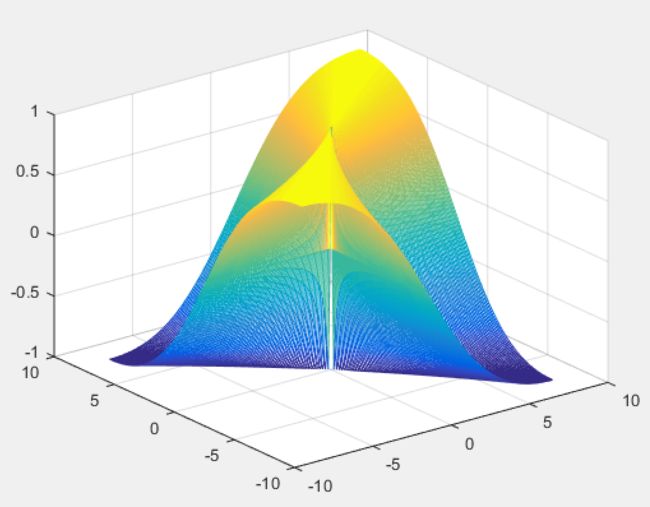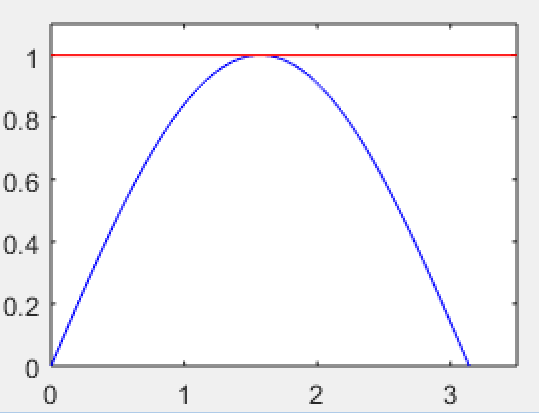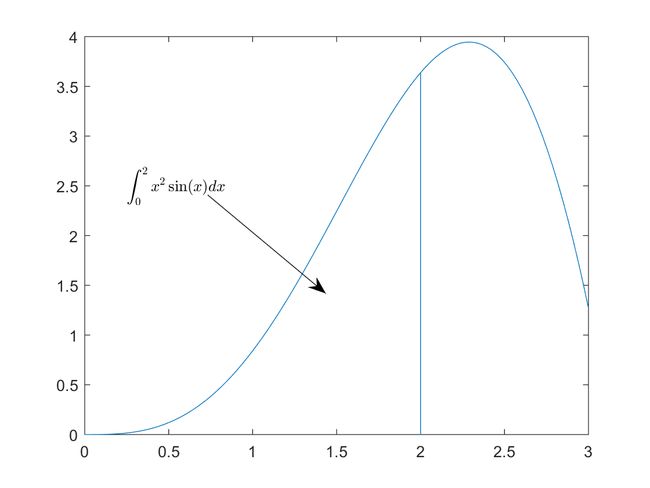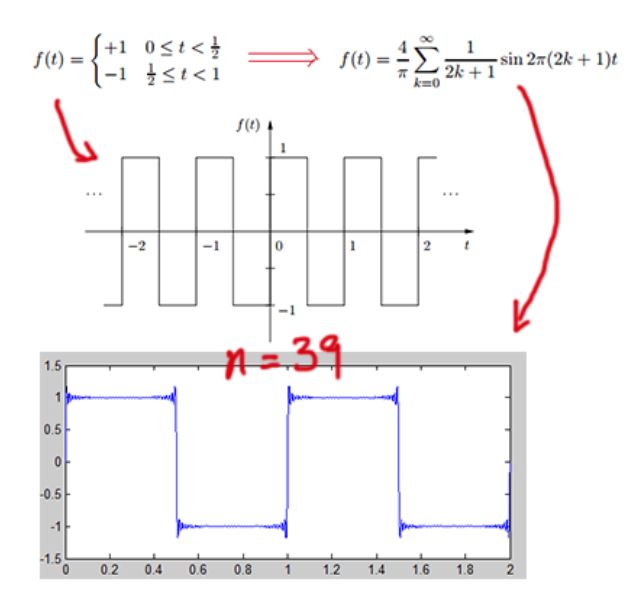【Matlab】关于Matlab的一些代码片段
转载,请保持连接:http://blog.csdn.net/stalendp/article/details/44904639
这篇文章收集关于Matlab的一些代码片段,以便查阅:
function [] = myFunc(n)
t = 0:0.001:2;
y = myFunc0(t, n);
figure;
plot(t, y);
end
% 方波
function [ y ] = myFunc0( t, n )
rt = 0;
for k = 0:n
rt = rt + sin(2*pi*(2*k+1)*t)/(2*k+1);
end
y = rt * 4 / pi;
end
方波图如下:
2) 打印3D曲面:
[x,y] = meshgrid(-8:.1:8); z = (2.*x.*y)./(x.*x + y.*y); mesh(x,y,z);

3. 一些打印技巧:
% example 1 x = linspace(0,pi); y = sin(x); ymax = max(y); figure(1) plot(x, y, '-b') hold on plot(xlim, [1 1]*ymax, '-r') hold off axis([xlim 0 1.1]) % example 2 x = linspace(0,5,1000); y = sin(100*x)./exp(x); ax1 = subplot(2,1,1); plot(x,y) ax2 = subplot(2,1,2); plot(x,y) xlim(ax2,[0 1])


4. 函数的一些使用技巧(function handler, anonymous function); 可以使用matlab中的类来 更好的管理函数模块,请参考5中的方法
function study(n)
sqr = @(nn) nn.^2;
C = {@e1, @e2, @e3, @e4, @() sqr(3)};
C{n}()
end
%相关快捷键:Ctrl+R, Ctrl+T, Ctrl+I %{ %}
function e1
disp('This is example1');
figure(1)
x = linspace(0,pi);
y = sin(x);
ymax = max(y);
plot(x, y, '-b')
hold on
plot(xlim, [1 1]*ymax, '-r')
hold off
axis([xlim 0 1.1])
end
function e2
disp('This is example2');
figure(2)
x = linspace(0,5,1000);
y = sin(100*x)./exp(x);
ax1 = subplot(2,1,1);
plot(x,y)
ax2 = subplot(2,1,2);
plot(x,y)
xlim(ax2,[0 1])
end
function e3
disp('This is example3');
figure(3)
[x,y] = meshgrid(-8:.1:8);
z = (2.*x.*y)./(x.*x + y.*y);
mesh(x,y,z);
end
function e4
disp('This is example4');
figure(4)
myFunc(20);
end
5. 用类的方式来管理函数模块
classdef myclass
properties
end
methods
function e1(obj)
disp('This is example1');
figure(1)
x = linspace(0,pi);
y = sin(x);
ymax = max(y);
plot(x, y, '-b')
hold on
plot(xlim, [1 1]*ymax, '-r')
hold off
axis([xlim 0 1.1])
end
function e2(obj)
disp('This is example2');
figure(2)
x = linspace(0,5,1000);
y = sin(100*x)./exp(x);
ax1 = subplot(2,1,1);
plot(x,y)
ax2 = subplot(2,1,2);
plot(x,y)
xlim(ax2,[0 1])
end
function e3(obj)
disp('This is example3');
figure(3)
[x,y] = meshgrid(-8:.1:8);
z = (2.*x.*y)./(x.*x + y.*y);
mesh(x,y,z);
end
function e4(obj)
disp('This is example4');
figure(4)
myFunc(20);
end
end
end
6. 当然matlab还有非常赞的publish功能,请参考: Publishing MATLAB Code from The Editor
7. 高分辨率下,matlab自动改变分辨率的bug的解决方案:Matlab Changes reslution after opening simulink
8.用LaTeX来输出公式; 更多公式符号请参考:https://en.wikibooks.org/wiki/LaTeX/Mathematics
8-1)积分公式
x = linspace(0,3); y = x.^2.*sin(x); plot(x,y) line([2,2],[0,2^2*sin(2)]) str = '$$ \int_{0}^{2} x^2\sin(x) dx $$'; text(0.25,2.5,str,'Interpreter','latex') annotation('arrow','X',[0.32,0.5],'Y',[0.6,0.4])
8-2) 求和公式
x = linspace(-3,3); y = sin(x); plot(x,y) y0 = x; hold on plot(x,y0) y1 = x - x.^3/6; plot(x,y1) hold off str = '$$\sin(x) = \sum_{n=0}^{\infty}{\frac{(-1)^n x^{2n+1}}{(2n+1)!}}$$'; % text(-2,1,str,'Interpreter','latex') title(str,'Interpreter','latex');


9. Matlab字体设置; home->preference->Fonts; 推荐字体:雅黑、Consolas、Mono;其中Mono、Consolas都不支持中文,可以用和雅黑的结合体(点击链接可以转到下载页面):雅黑+Mono, 雅黑+Consolas;
另外,介绍一篇关于编程字体的文章:有哪些适合用于写代码的西文字体?
10. 漂亮地输出公式:
A = sym(pascal(2)); B = eig(A); pretty(B) // 结果如下: / 3 sqrt(5) \ | - - ------- | | 2 2 | | | | sqrt(5) 3 | | ------- + - | \ 2 2 /
11. Matlab打印矩阵的LaTeX的获取:
A = [1 2 3; 4 5 6; 7 8 9]; latex_table = latex(sym(A))
输出结果为:
12. pretty 和 LaTeX输出的区别:同样一个矩阵,可以在控制台输出(用pretty),也可以在plot窗口或者publish页面(用LateX)显示。
用11中的矩阵做例子:
%% 测试 pretty 和 LaTeX A = [1 2 3; 4 5 6; 7 8 9]; % pretty 代码 pretty(sym(A)); % plot 代码: str = ['$$', latex(sym(A)), '$$']; title(str ,'Interpreter','latex')
